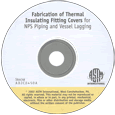We need your consent to use the individual data so that you can see information about your interests, among other things. Click "OK" to give your consent.
ASTM C450-18
Standard Practice for Fabrication of Thermal Insulating Fitting Covers for NPS Piping, and Vessel Lagging
Translate name
STANDARD published on 1.4.2018
The information about the standard:
Designation standards: ASTM C450-18
Publication date standards: 1.4.2018
SKU: NS-845253
The number of pages: 10
Approximate weight : 30 g (0.07 lbs)
Country: American technical standard
Category: Technical standards ASTM
The category - similar standards:
Annotation of standard text ASTM C450-18 :
Keywords:
dimensions, thermal insulating materials, thermal insulating materials´fabrication, thermal insulating materials´fittings, thermal insulating materials´pipe ,, ICS Number Code 27.220 (Heat recovery. Thermal insulation)
These adjuncts apply to this standard:
Adjunct to C450 Standard Practice for Fabrication of Thermal Insulating Fitting Covers for NPS Piping, and Vessel Lagging
Selected format:Show all technical information.
Additional information
| Significance and Use | ||||
|
4.1 This system of dimensions provides a guide for forming thermal insulation in advance of field application. Forming is done by cutting, grinding, milling, or molding, depending upon the method most suitable for the thermal insulation being fabricated. It is equally applicable for all service temperature ranges. |
||||
| 1. Scope | ||||
|
1.1 This practice provides tables of dimensions of preformed pipe insulation that shall be used in fabricating insulation covers for use on valves, ells, tees, flanges, and vessels in the pressure range from 150 to 1500 psi (1 to 10 MPa). These tables, which are part of this standard, are published separately as the ASTM Recommended Dimensional Standards for Fabrication of Thermal Insulation Fitting Covers for NPS Piping and Vessel Lagging. In addition, the ADJC0450A tables for Short Radius (SR) and Long Radius (LR) Elbows Insulation Fitting Covers for piping are included in this practice. The tables were developed to provide dimensions for shop fabrication use in forming pipe insulation fitting covers on NPS pipe operating at high temperature and low temperature. The tables also include dimensions for use in forming thermal insulation into curved segments, and lagging, for application on vessels. This practice does not apply to reflective-type insulation, insulation on screwed elbows, Short Radius (SR) and Long Radius (LR) Elbows Fitting Covers for tubing, dutchman (extended leg) insulation fitting covers, double-layered staggered-joint pipe insulation fitting covers, flexible preformed pipe-tube elastomeric foam fitting covers in accordance with Specification C534/C534M or polyolefin foam fitting covers in accordance with Specification C1427. 1.1.1 Refer to Guide C1710 when referring to insulation materials for fabrication of preformed flexible closed cell insulated 90° elbows, tees, or similar products. 1.2 This practice does not specify fabrication methods. Thermal insulation for fitting covers is formed by numerous fabrication methods. In general, insulations are cut by circular or band saws, shaped by grinders or millers, or molded/preformed. Each method has certain advantages and disadvantages, depending upon the material to be formed, number of cuts required, material waste permissible, and quantity of fittings being produced. Fitting parts are assembled using adhesives and fabrication cements applied using dip pots, rollers, doctor blades, brush, or trowel, depending upon the materials being used. Any specification of the fabrication techniques is beyond the scope of this standard. 1.3 The values stated in inch-pound units are to be regarded as standard. In a few parts of this practice, the values given in parentheses are mathematical conversions to SI units that are provided for information only and are not considered standard. The dimensional standard tables with fractional inch-pound (I.P.) system provided from the adjunct and in this document’s tables are currently not available in decimal and metric equivalents. 1.4 This standard does not purport to address all of the safety concerns, if any, associated with its use. It is the responsibility of the user of this standard to establish appropriate safety, health, and environmental practices and determine the applicability of regulatory limitations prior to use. 1.5 This international standard was developed in accordance with internationally recognized principles on standardization established in the Decision on Principles for the Development of International Standards, Guides and Recommendations issued by the World Trade Organization Technical Barriers to Trade (TBT) Committee. |
||||
| 2. Referenced Documents | ||||
|




 Cookies
Cookies
